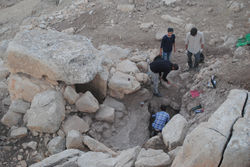Jebel al-Mutawwaq
 |  |  |  |  |
|---|---|---|---|---|
 |
Season 2013
Excavation results of the Spanish-Italian expeditions
The new 2013 archaeological expedition (August/September 2013) gave important results, helping the comprehension of the relationship between the EB I settlement and the megalithic necropolis. In particular two excavation areas were opened, one on the south-eastern part of the settlement wall, in order to understand the function and the effective purpose of the fence, the second on three dolmens located near the eastern part of the settlement, resulting almost completely buried and sealed.
The excavation of the first area (A) identified the corner of the settlement wall, evidencing its construction technique: a foundation of medium size stones leveling the bedrock and at least three rows of large stones. The wall is connected to a settlement door, opening to the East toward the necropolis. The most interesting feature of this area is the identification of an outer street, well constructed, with two rows of stones and a middle layer of pebbles and smaller stones. The street runs from the settlement wall toward the dolmens visible in the south-eastern area of the mountain.In the second area of excavation (B), centered on the three well preserved dolmen (numbers 316, 321, 317), another part of the same street was recovered. This street, oriented in the West-East direction, is leading clearly toward the southern and larger dolmen (number 316), crossing with another street, running in South-North direction. The other two northern dolmens (number 321, 317) are also well preserved and are not in phase with the main street, clearly cut by them. This indicate two different phases of the necropolis, till now dated to the Early Bronze Age I. The presence of a network of streets inside the necropolis, connecting the dolmen field to the main south-eastern door of the settlement, strengths the link between the village and the megalithic funerary area, indicating a rising complexity in the society and in the settlement organization in this proto-urban period.
Another important result of this campaign comes from the excavation to the three well preserved and sealed burial chambers of the dolmens. While two of them were recovered emptied and sealed with stones in Early Bronze I, probably during the first abandonment of the site, another one, Dolmen 317, was recovered emptied just in the upper part. In fact, two flat stones divided the burial chamber in two part, and the lower one was recovered perfectly intact. A complete burial, denominated B.25, was identified with a skull very well preserved: the burial was preserved also for the other long bones, decomposed and piled in front of the skull. The presence of many other small bones, like ribs and phalanges, probably indicates that the dead was first decomposed inside the dolmen burial chamber and later his bones were re-arranged. The most interesting feature of B.25 is the funerary gift associated with him. In fact, instead of the typical pottery usually associated with the EB I burials discovered in the Southern Levant, we found only two flint tools, very well worked. One of that is a large and flat circular flint with a thin blade. Similar tools were recovered in the past excavations to the site only in four exemplars, all found in the sacred area denominated Temple of Snakes- This burial gift connects B.25 with an attendant of the settlement sanctuary. The fact that Dolmen 317 was the only burial discovered till now in this necropolis, were dolmens were usually completely emptied and sealed after the end of their use, could be related to a man linked by a special status to the EB I village.

Describe your image

Describe your image

Describe your image

Describe your image